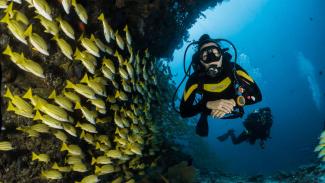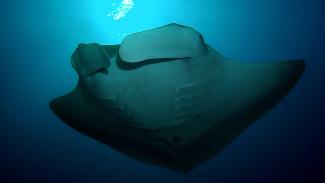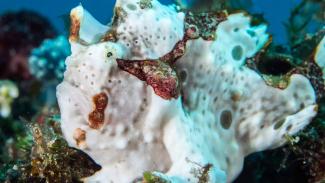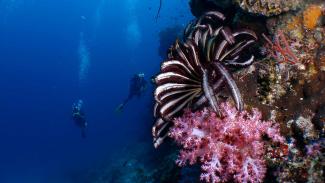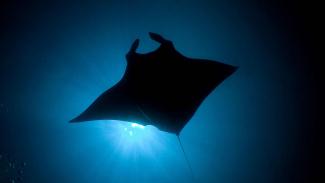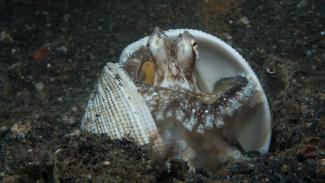Discover the best dive sites of Komodo National Park
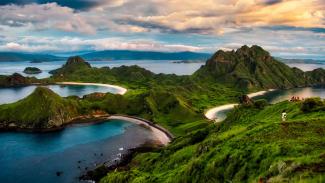
Fajruddin Mudzakkir
Komodo National Park is the home of the Komodo Dragon - and also some of the best diving in Indonesia.
It is a popular liveaboard diving destination.
The national park comprises of two main islands, Komodo Island and Rinca Island, along with numerous smaller islets. These current swept islands of Komodo are home to a huge amount of diversity, wonderful coral reefs, a profusion of marine life and no shortage of pelagic action.
While Komodo has become a popular liveaboard diving destinations due to its size, good dive resort options also available from Labuanbajo.
Highlights

Best diving spots
Banta Island in the north-west offers a variety of truly outstanding dives. If you want to see Sharks, this is a great place to dive. It is not always possible to dive some of the sites due to the fierce currents, but a dive at GPS Point, Gallery Rock or Tajung Rasa will surely put a smile on the face of any Shark lover. Star Wars & Toro Oi offer different diving, with a profusion of smaller reef-fish and fascinating critters such as Sea Apples & Pygmy Seahorses. Also in the north of Komodo, Tatawa Besar & Kecil are very popular drift dives, bringing the chance to see huge Napoleon Wrasse, Green Turtles and Reef Sharks.
At the south of Komodo Island lies Tata Island. Here, from September through to March, large aggregations of Manta Rays come to feed on the plankton rich waters. Many other pelagic species can be seen as well. For really experienced divers, Langkoi Rock attracts many different Sharks, including occasional Hammerheads. It is reportedly a breeding area for Grey Reef Sharks. Small Makasar, a sandy plateau to the east of Komodo Island is another great spot to find large schools of Manta Rays. Dugongs have occasionally been seen here too.
Looking for the latest liveaboard deals in Indonesia? Find your deal
At the southern end of Rinca Island, dive spots such as Kode are blessed with abundant soft corals and unusual critters are the order of the day. Coleman’s Shrimps, numerous Nudibranches, Pygmy Seahorses, Sea Apples and a myriad of other rare creatures can be found here.
The diving around Komodo and Rinca is generally split into northern sites and southern sites. The area is a meeting point of temperate waters to the south and tropical waters to the north, meaning warm, clear tropical waters on the northern sites and cooler, plankton rich waters to the south. All but the most protected sites can receive very strong currents and are only suitable for more experienced divers.
When to dive
The region can be dived year-round, although the months of April to October are the best time to dive Komodo, particularly with liveaboards who focus on this area during this period. Outside of these months can occasionally bring rougher seas, but sometimes also great visibility.
Getting there
To reach Komodo National Park, first head to the town of Labuanbajo on Flores Island. There are regular flights to Labuanbajo from Bali, Jakarta or Lombok to the west and Maumere to the east. Labuanbajo is generally the embarkation point of most liveaboards and also home to most of Komodo's dive resorts.
Ferries also take tourists on cruises from Bali and Lombok that stop in Labuanbajo. Those really on a budget can island hop by land and ferry from Bali to Flores, but this takes a long time and a lot of patience.
Activities
Apart from scuba diving, the main activity is a visit to Komodo or Rinca to see the legendary Komodo Dragons. There are also a couple of idyllic islands nearby with nice beaches and accommodation options where divers can relax and recuperate after a few days diving.
Resort and liveaboard options
Komodo National Park is an immensely popular liveaboard diving destination, with itineraries ranging from 4 to 11 nightson offer, and a wide range of vessels. The main liveaboard diving season is from June to October, however there is great diving outside these months too, with some liveaboards staying in the Komodo region throughout the year.
We recommend the team at Liveaboard.com to find your perfect Komodo liveaboard adventure.
Resort options are also available offering a different experience, but equally impressive diving. Many resort options are around Labuanbajo on the west coast of Flores. There are also options on islands outside the national park.
How to dive Komodo National Park
Komodo National Park covers a large area and is best dived by liveaboard to fully appreciate the area's riches. Itineraries vary from 3 nights to 11 nights and cater for a wide range of budgets, with over 60 options to choose from with liveaboard.com. Suggested budget options include the Empress II, the Nustantara and the Jaya liveaboards. Mid-range options include Lady Denok, the characterful Calico Jack and the Ilike. Outstanding splurge options include the Corali liveaboard, the luxurious Tiare cruise and the Damai I.
Most liveaboard itineraries begin from Labuanbajo, requiring a domestic flight from Bali. The Mermaid I and Mermaid II liveaboard begins from Bali however, avoiding the hassle of a domestic flight, but reducing dive time in Komodo National Park itself.
The main Komodo diving season begins in May or June and runs through to September or October, however some liveaboards, such as the magnificent Adelaar, are stationed in Komodo for much of the year.
Komodo National Park Snapshot
- When to go: High season is from May through to October, but can be dived throughout the year.
- Marine life highlights: Manta Rays, numerous species of Shark, Dugong.
- How to reach: Most liveaboard departures begin and end in Labuanbajo, with limited options from Bali.
- Prices guide: Liveaboards begin from around USD170 per day, rising in luxury to over USD400 per day.


